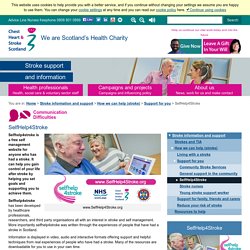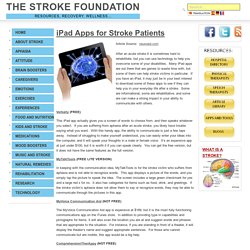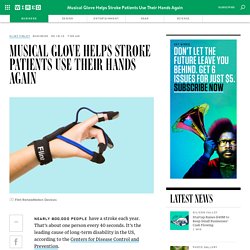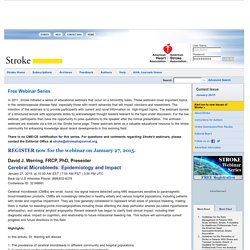

HemiHelp: for children and young people with hemiplegia (hemiparesis) Self management website for people who have had a stroke. SelfHelp4Stroke - Chest Heart & Stroke Scotland. Www.SelfHelp4Stroke.org Selfhelp4stroke is a free self management website for anyone who has had a stroke.

It can help you gain control of your life after stroke by helping you set goals and supporting you to achieve them. Selfhelp4stroke has been developed by healthcare professionals, researchers, and third party organisations all with an interest in stroke and self management. More importantly selfhelp4stroke was written through the experiences of people that have had a stroke in Scotland. Information is displayed in video, audio and interactive formats offering support and helpful techniques from real experiences of people who have had a stroke. John helps guide you around the website, explaining each section, so you have an understanding of what it is about before you start.
Welcome to the CADASIL Website — cadasil. BBC Radio 4 - The Life in My Head: From Stroke to Brain Attack, Episode 2. iPad Apps for Stroke Patients. Article Source: neuroaid.com After an acute stroke it is sometimes hard to rehabilitate, but you can use technology to help you overcome some of your disabilities.

Many iPad apps are out there that are games to waste time with, but some of them can help stroke victims in particular. If you have an iPad, it may just be in your best interest to download some of these apps to see if they can help you in your everyday life after a stroke. Some are informational, some are rehabilitative, and some are can make a strong impact in your ability to communicate with others. Verbally (FREE) This iPad app actually gives you a screen of words to choose from, and then speaks whatever you select. MyTalkTools (FREE LITE VERSION) In keeping with the communication idea, MyTalkTools is for the stroke victim who suffers from aphasia and is not able to recognize words. MyVoice Communication Aid (NOT FREE) ComprehensionTherAppy (NOT FREE) ComprehensionTherAppy is a fun game for anyone who has had a stroke.
Musical Glove Helps Stroke Patients Use Their Hands Again. Nearly 800,000 people have a stroke each year.

That’s about one person every 40 seconds. It’s the leading cause of long-term disability in the US, according to the Centers for Disease Control and Prevention. There are many treatments that help stroke patients recover lost abilities. But the problem, says Nizan Friedman, founder of Flint Rehabilitation Devices, is that too few patients keep up with their therapy after leaving the hospital. “They’re left at home, with just a list of exercises that the therapist gives them to do,” he says. Friedman hopes to change that with MusicGlove, a wearable computing device designed to help patients improve their fine motor skills. People were trying and crying afterwords. These are, for the most part, the same sort of exercises they’d be told to perform after leaving the hospital. Made Possible by Cheaper Computing. Extracranial atherosclerosis ECAS. Internet Stroke Center.
Webinar Series. In 2011, Stroke initiated a series of educational webinars that occur on a bimonthly basis.

These webinars cover important topics in the cerebrovascular disease field, especially those with recent advances that will impact clinicians and researchers. The intention of the webinars is to provide participants with current and novel information on high-impact topics. The webinars consist of a structured lecture with appropriate slides by acknowledged thought leaders relevant to the topic under discussion. For the live webinar, participants then have the opportunity to pose questions to the speaker after the formal presentation. The archived webinars are available via a link on the Stroke home page. There is no CME/CE certification for this series. REGISTER now for the webinar on January 27, 2015. David J. Cerebral microbleeds (CMBs) are small, round, low signal lesions detected using MRI sequences sensitive to paramagnetic blood-breakdown products.
Neuroanatomy Stroke Model. Cerebral venous sinus thrombosis. Hemorrhagic Stroke: Types. Chronic subdural hematoma.
Stroke Survivor Education Resources. Stroke Research. Arrhythmia Alliance - Home. InterAct Reading Service. 233995 out of the blue stroke survivors choir sept 2. Home - Atrial Fibrillation (AFA) - AFA Home. Deaf stroke results. Deaf stroke leaflet.